Abstract
The severity of anaemic decerebrate rigidity was quantitatively determined by measuring the frequency of electromyographic potentials in the rat. Some oxazolidinones markedly reduced the severity of this decerebrate rigidity in a dose-dependent manner, (4S,5R)-4-(2-methylpropyl)-3- [3-(perhydroazepin-1-yl)propyl]-5-phenyl-1,3-oxazolidin-2-on e (MLV-6976) being the most potent. In addition to the oxazolidinones, an aminoalcohol derivative, (1RS,2SR)-5-methyl-1-phenyl-2-(3-piperidinopropylamino )hexan-1-ol (MLV-5860) also reduced the rat decerebrate rigidity. In the oxazolidinone series, the optical isomers with absolute configuration (S) at the 4-position were more potent than the corresponding (4R)-isomers, while there was no significant difference in their LD50 values. Normal rats and mice receiving MLV-6976 at doses which reduced decerebrate rigidity showed no behavioural changes, impairment of motor coordination only appearing at extremely high doses. MLV-6976 and its derivatives did not affect spinal reflex potentials in cats. MLV-6976 reduced the severity of harmaline-induced tremor in mice in a dose-dependent manner, but slightly augmented tremorine-induced tremor. The frequency of the spike discharges induced by iontophoretically applied glutamate was reduced by MLV-6976 in a dose-dependent manner in rat cortical neurones. The amplitude of miniature endplate potentials of the rat diaphragm was decreased by MLV-6976 only at concentrations greater than 0.1 mM. It is concluded that MLV-6976 acts on the brainstem or/and higher levels of the brain rather than on the spinal cord or the peripheral nervous system to reduce the excessive activities of the nervous system.
Full text
PDF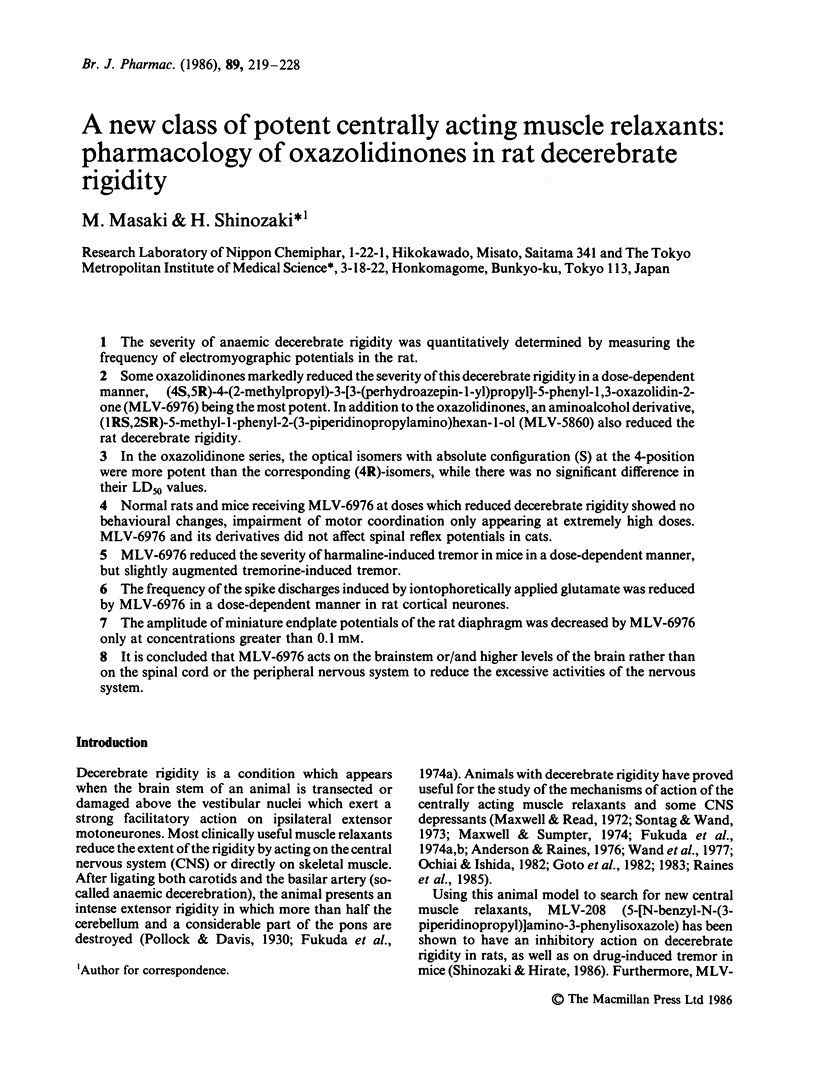
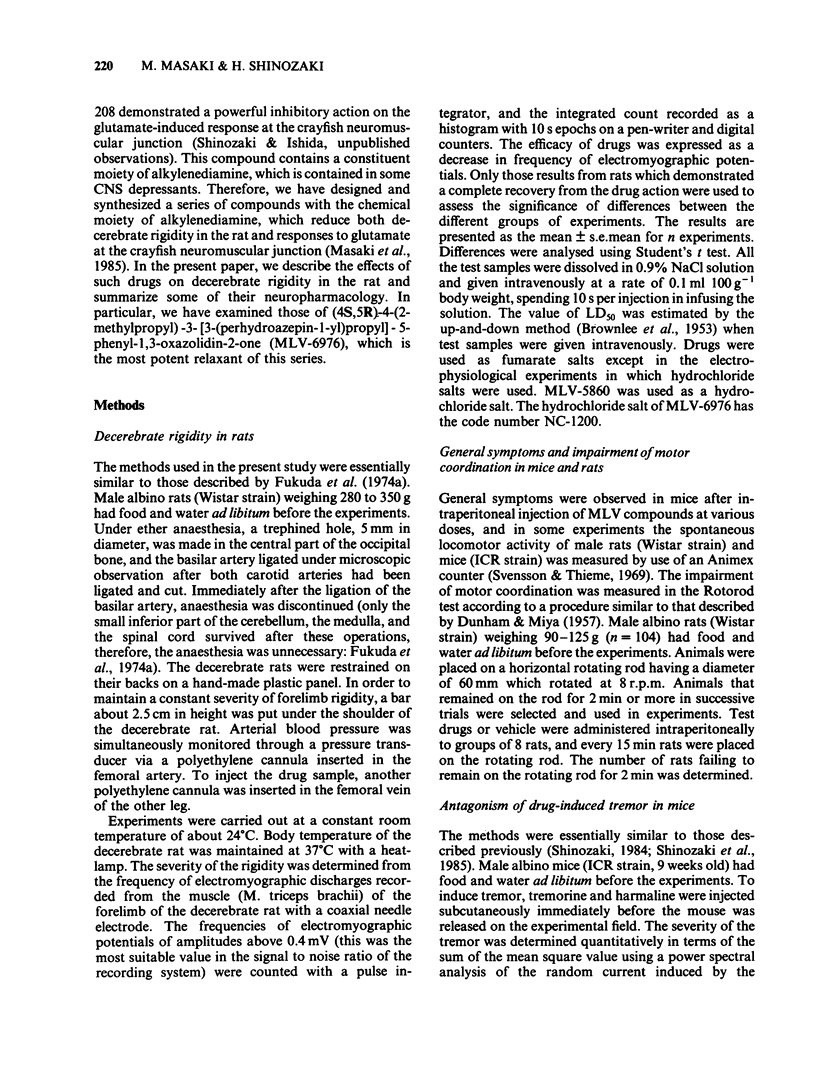
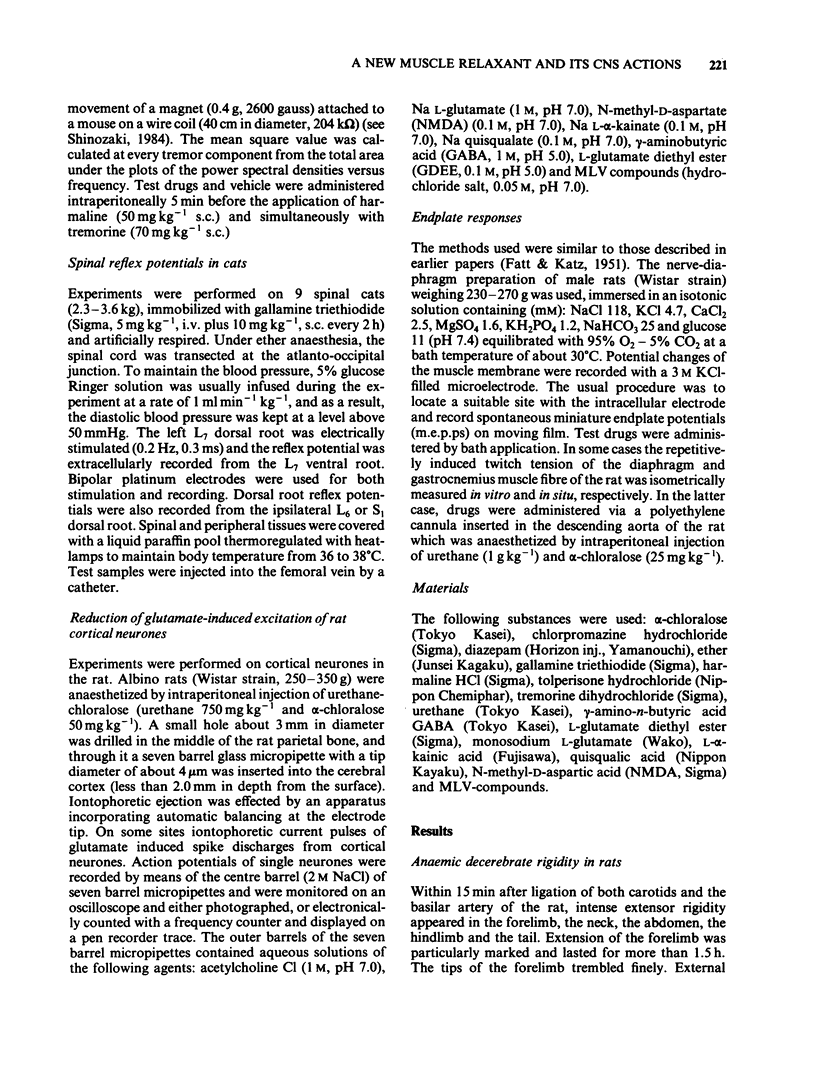
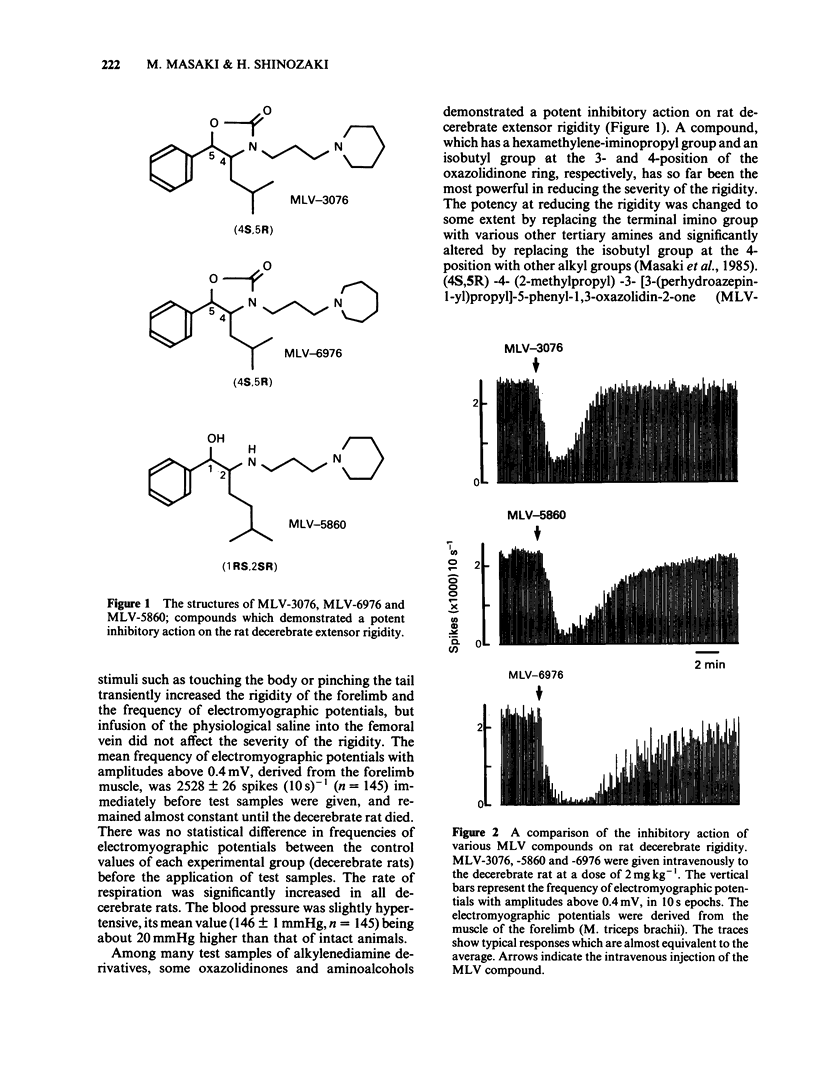
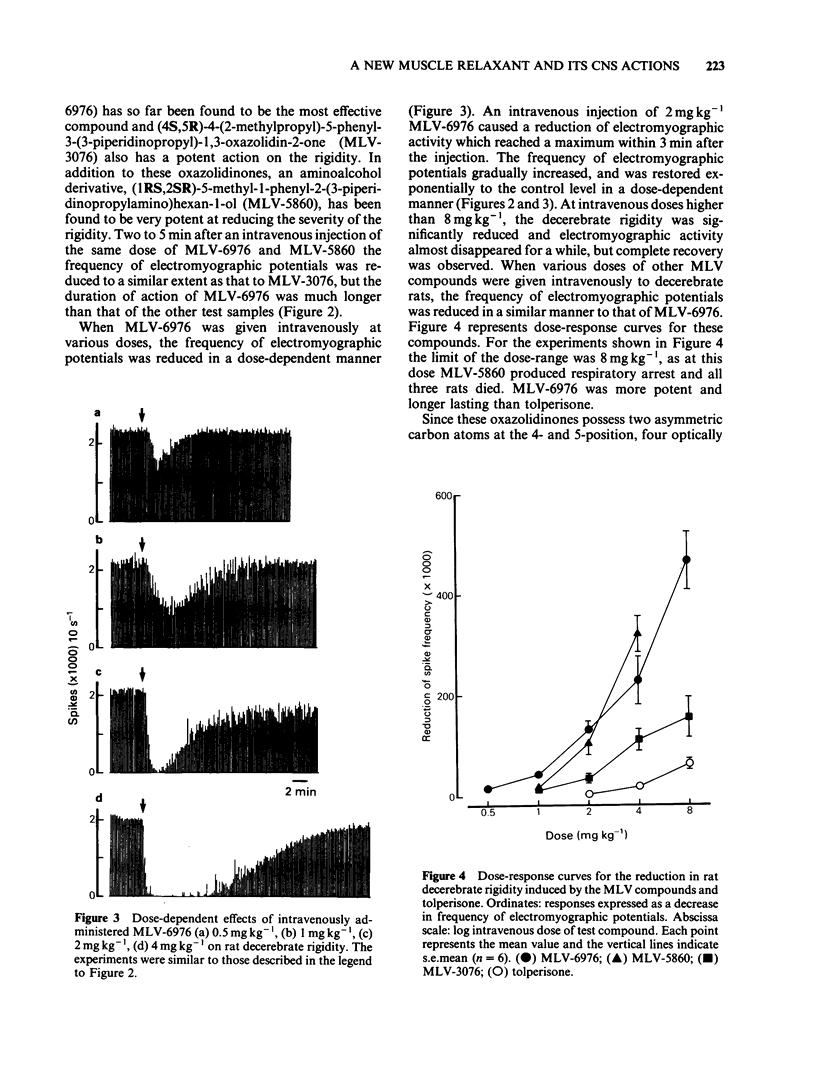
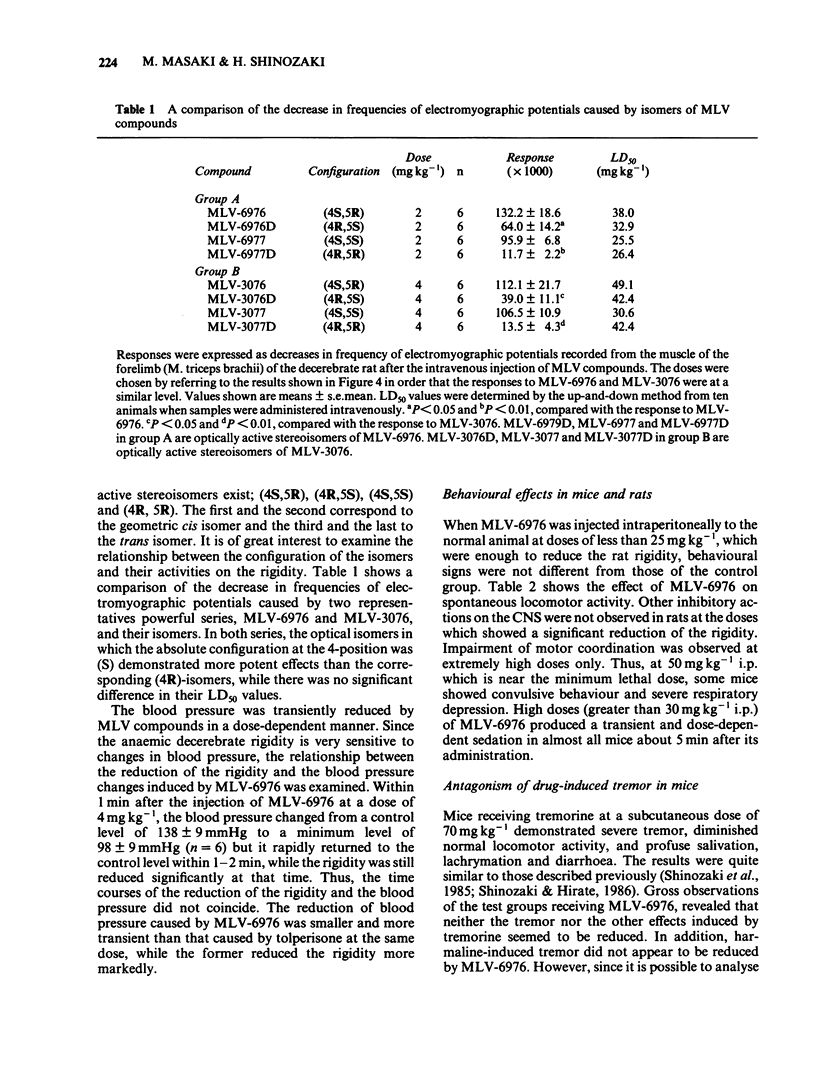
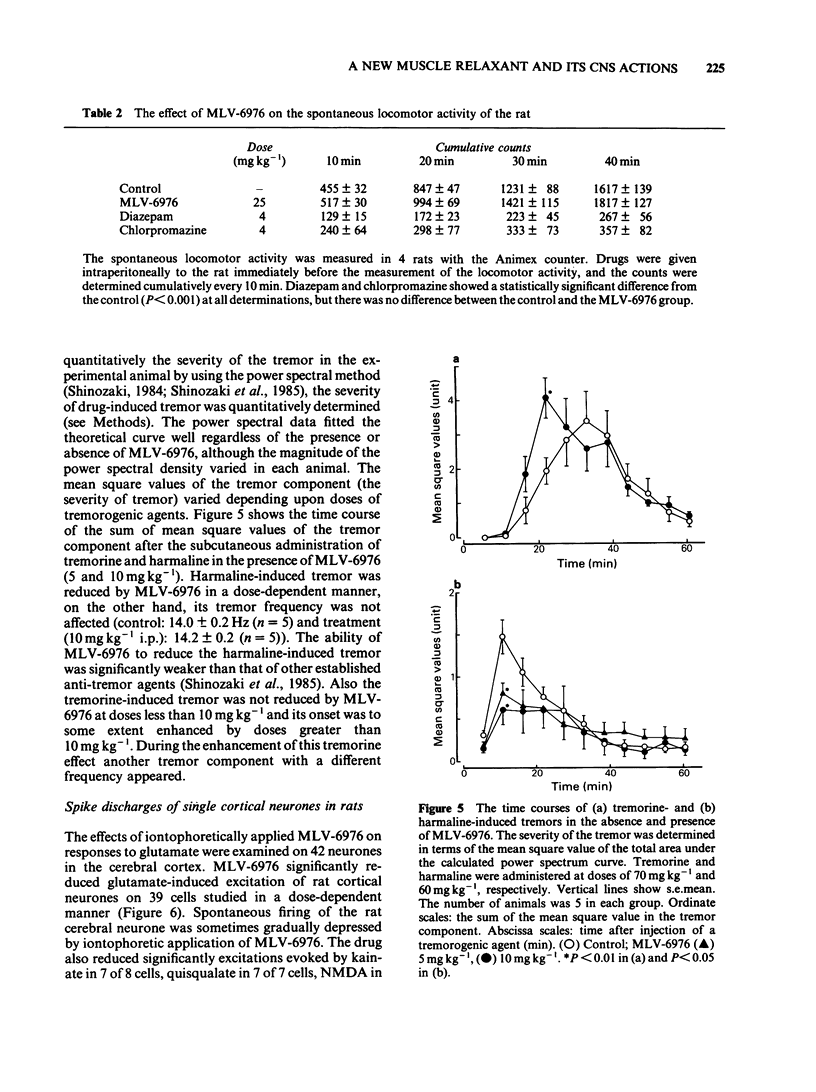
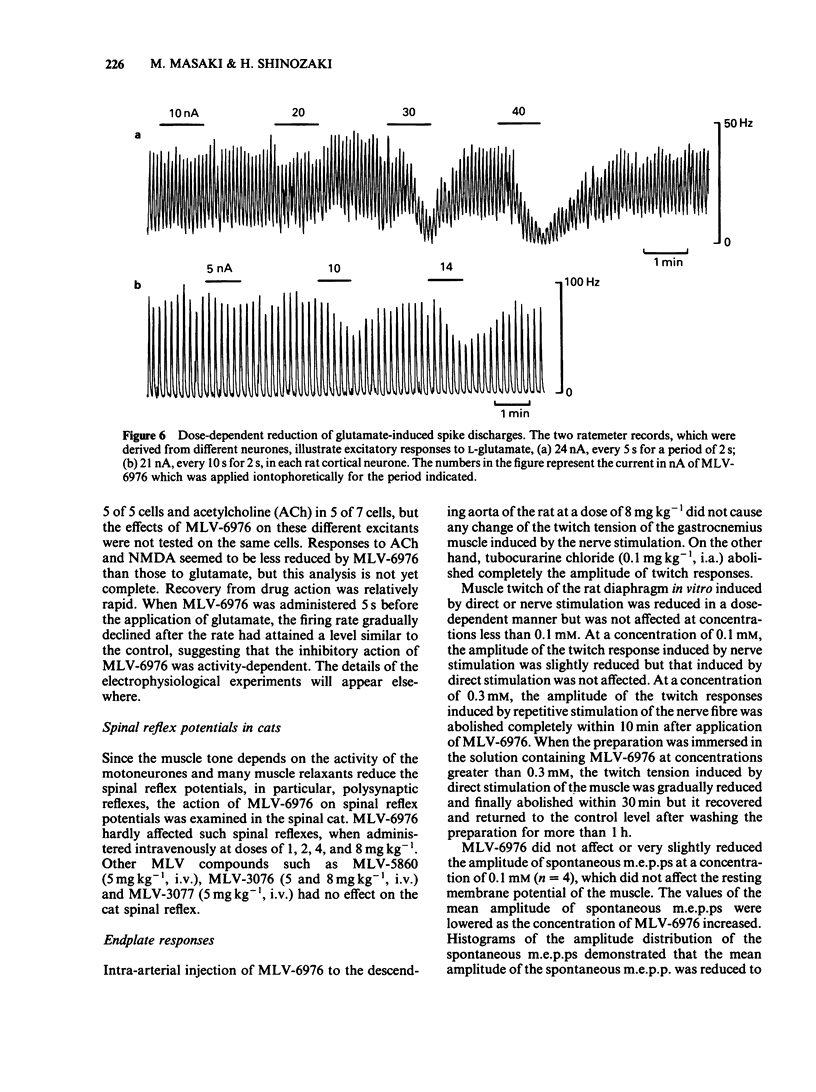
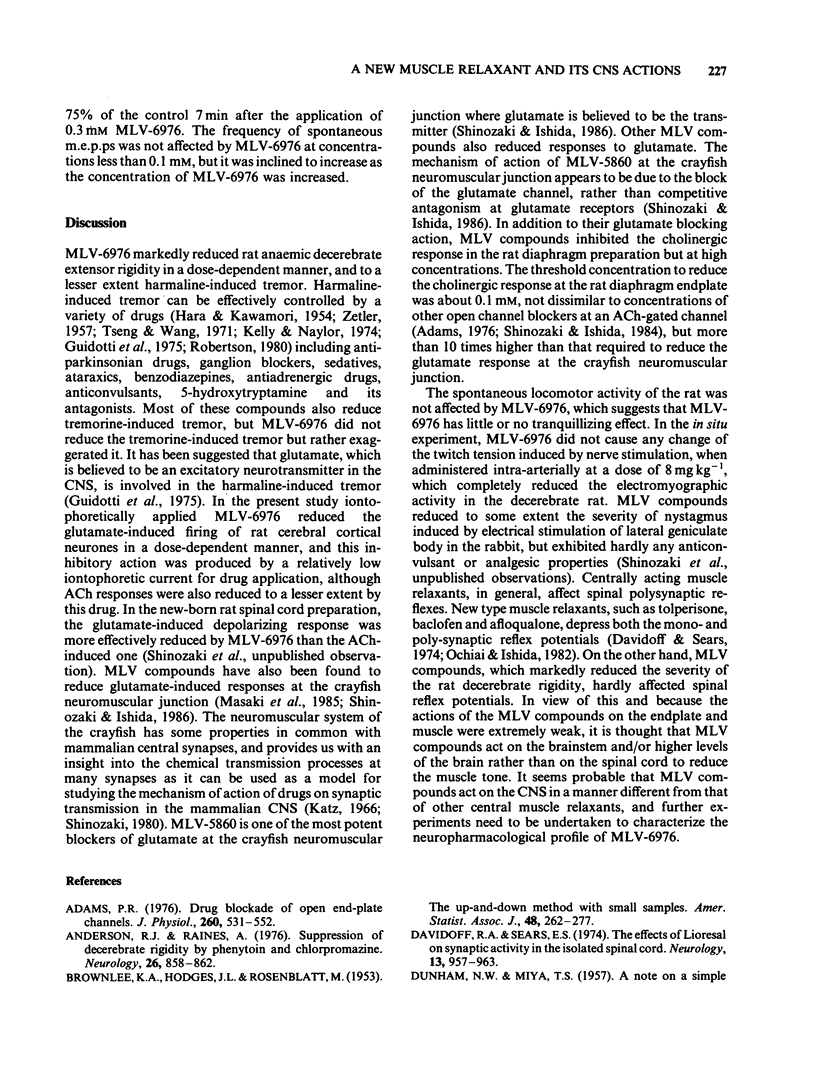
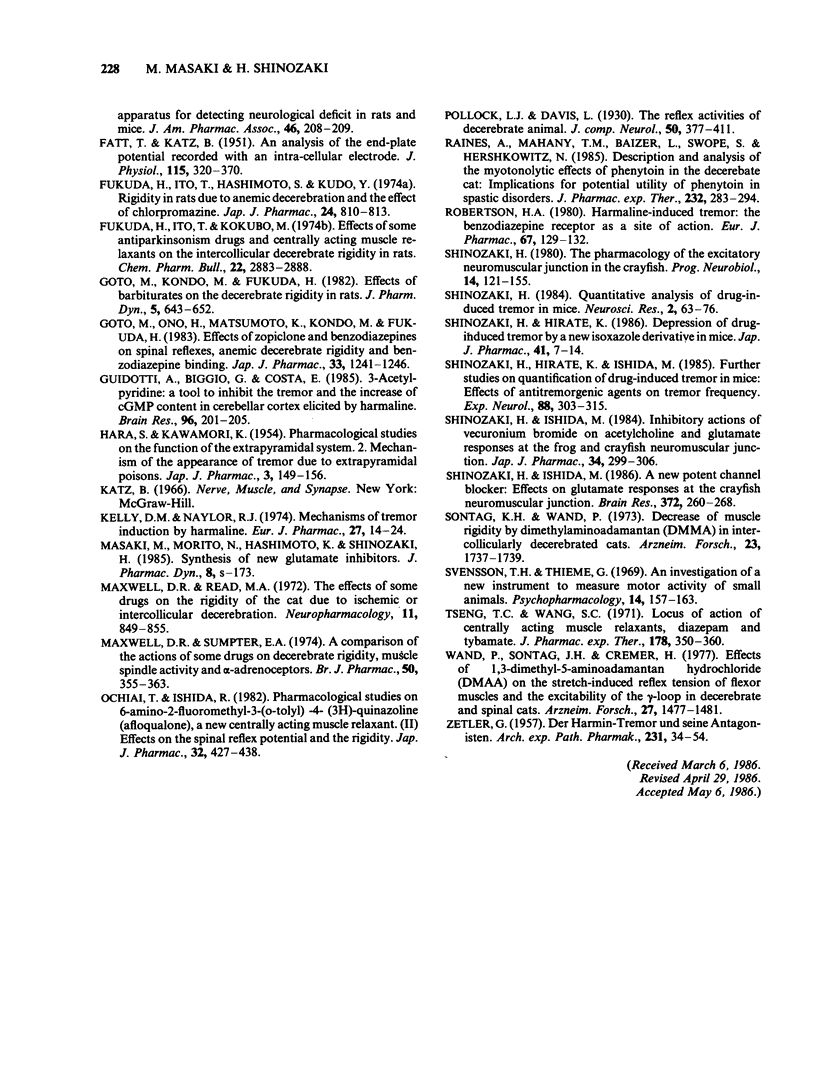
Selected References
These references are in PubMed. This may not be the complete list of references from this article.
- Adams P. R. Drug blockade of open end-plate channels. J Physiol. 1976 Sep;260(3):531–552. doi: 10.1113/jphysiol.1976.sp011530. [DOI] [PMC free article] [PubMed] [Google Scholar]
- Anderson R. J., Raines A. Suppression of decerebrate rigidity by phenytoin and chlorpromazine. Neurology. 1976 Sep;26(9):858–862. doi: 10.1212/wnl.26.9.858. [DOI] [PubMed] [Google Scholar]
- DUNHAM N. W., MIYA T. S. A note on a simple apparatus for detecting neurological deficit in rats and mice. J Am Pharm Assoc Am Pharm Assoc. 1957 Mar;46(3):208–209. doi: 10.1002/jps.3030460322. [DOI] [PubMed] [Google Scholar]
- Davidoff R. A., Sears E. S. The effects of Lioresal on synaptic activity in the isolated spinal cord. Neurology. 1974 Oct;24(10):957–963. doi: 10.1212/wnl.24.10.957. [DOI] [PubMed] [Google Scholar]
- FATT P., KATZ B. An analysis of the end-plate potential recorded with an intracellular electrode. J Physiol. 1951 Nov 28;115(3):320–370. doi: 10.1113/jphysiol.1951.sp004675. [DOI] [PMC free article] [PubMed] [Google Scholar]
- Fukuda H., Ito T., Hashimoto S., Kudo Y. Rigidity in rats due to anemic decerebration and the effect of chlorpromazine. Jpn J Pharmacol. 1974 Oct;24(5):810–813. doi: 10.1254/jjp.24.810. [DOI] [PubMed] [Google Scholar]
- Fukuda H., Ito T., Kokubo M. Effects of some antiparkinsonism drugs and centrally acting muscle relaxants on the intercollicular decerebrate rigidity in rats. Chem Pharm Bull (Tokyo) 1974 Dec;22(12):2883–2888. doi: 10.1248/cpb.22.2883. [DOI] [PubMed] [Google Scholar]
- Goto M., Kondo M., Fukuda H. Effects of barbiturates on the decerebrate rigidity in rats. J Pharmacobiodyn. 1982 Sep;5(9):643–652. doi: 10.1248/bpb1978.5.643. [DOI] [PubMed] [Google Scholar]
- Goto M., Ono H., Matsumoto K., Kondo M., Fukuda H. Effects of zopiclone and benzodiazepines on spinal reflexes, anemic decerebrate rigidity and benzodiazepine binding. Jpn J Pharmacol. 1983 Dec;33(6):1241–1246. doi: 10.1254/jjp.33.1241. [DOI] [PubMed] [Google Scholar]
- Guidotti A., Biggio G., Costa E. 3-Acetylpyridine: a tool to inhibit the tremor and the increase of cGMP content in cerebellar cortex elicited by harmaline. Brain Res. 1975 Oct 10;96(1):201–205. doi: 10.1016/0006-8993(75)90598-3. [DOI] [PubMed] [Google Scholar]
- HARA S., KAWAMORI K. Pharmacological studies on the function of the extrapyramidal system. 2. Mechanism of the appearance of tremor due to extrapyramidal poisons. Jpn J Pharmacol. 1954 Mar;3(2):149–156. doi: 10.1254/jjp.3.149. [DOI] [PubMed] [Google Scholar]
- Kelly D. M., Naylor R. J. Mechanisms of tremor induction by harmine. Eur J Pharmacol. 1974 Jun;27(1):14–24. doi: 10.1016/0014-2999(74)90197-6. [DOI] [PubMed] [Google Scholar]
- Maxwell D. R., Read M. A. The effects of some drugs on the rigidity of the cat due to ischaemic or intercollicular decerebration. Neuropharmacology. 1972 Nov;11(6):849–855. doi: 10.1016/0028-3908(72)90043-3. [DOI] [PubMed] [Google Scholar]
- Maxwell D. R., Sumpter E. A. A comparison of the actions of some drugs on decerebrate rigidity, muscle spindle activity and alpha-adrenoceptors. Br J Pharmacol. 1974 Mar;50(3):355–363. doi: 10.1111/j.1476-5381.1974.tb09610.x. [DOI] [PMC free article] [PubMed] [Google Scholar]
- Ochiai T., Ishida R. Pharmacological studies on 6-amino-2-fluoromethyl-3-(O-tolyl)-4(3H)-quinazolinone (afloqualone), a new centrally acting muscle relaxant. (II) Effects on the spinal reflex potential and the rigidity. Jpn J Pharmacol. 1982 Jun;32(3):427–438. doi: 10.1254/jjp.32.427. [DOI] [PubMed] [Google Scholar]
- Raines A., Mahany T. M., Baizer L., Swope S., Hershkowitz N. Description and analysis of the myotonolytic effects of phenytoin in the decerebrate cat: implications for potential utility of phenytoin in spastic disorders. J Pharmacol Exp Ther. 1985 Jan;232(1):283–294. [PubMed] [Google Scholar]
- Robertson H. A. Harmaline-induced tremor: the benzodiazepine receptor as a site of action. Eur J Pharmacol. 1980 Oct 3;67(1):129–132. doi: 10.1016/0014-2999(80)90020-5. [DOI] [PubMed] [Google Scholar]
- Shinozaki H., Hirate K. Depression of drug-induced tremor by a new isoxazol derivative in mice. Jpn J Pharmacol. 1986 May;41(1):7–14. doi: 10.1254/jjp.41.7. [DOI] [PubMed] [Google Scholar]
- Shinozaki H., Hirate K., Ishida M. Further studies on quantification of drug-induced tremor in mice: effects of antitremorgenic agents on tremor frequency. Exp Neurol. 1985 May;88(2):303–315. doi: 10.1016/0014-4886(85)90193-1. [DOI] [PubMed] [Google Scholar]
- Shinozaki H., Ishida M. A new potent channel blocker: effects on glutamate responses at the crayfish neuromuscular junction. Brain Res. 1986 May 7;372(2):260–268. doi: 10.1016/0006-8993(86)91133-9. [DOI] [PubMed] [Google Scholar]
- Shinozaki H., Ishida M. Inhibitory actions of vecuronium bromide on acetylcholine and glutamate responses at the frog and crayfish neuromuscular junction. Jpn J Pharmacol. 1984 Mar;34(3):299–306. doi: 10.1254/jjp.34.299. [DOI] [PubMed] [Google Scholar]
- Shinozaki H. Quantitative analysis of drug-induced tremor in mice. Neurosci Res. 1984 Dec;2(1-2):63–76. doi: 10.1016/0168-0102(84)90005-1. [DOI] [PubMed] [Google Scholar]
- Shinozaki H. The pharmacology of the excitatory neuromuscular junction in the crayfish. Prog Neurobiol. 1980;14(2-3):121–155. doi: 10.1016/0301-0082(80)90020-9. [DOI] [PubMed] [Google Scholar]
- Sontag K. H., Wand P. Decrease of muscle rigidity by dimethylaminoadamantan (DMMA) in intercollicularly decerebrated cats. Arzneimittelforschung. 1973 Dec;23(12):1737–1739. [PubMed] [Google Scholar]
- Svensson T. H., Thieme G. An investigation of a new instrument to measure motor activity of small animals. Psychopharmacologia. 1969;14(2):157–163. doi: 10.1007/BF00403689. [DOI] [PubMed] [Google Scholar]
- Tseng T. C., Wang S. C. Locus of action of centrally acting muscle relaxants, diazepam and tybamate. J Pharmacol Exp Ther. 1971 Aug;178(2):350–360. [PubMed] [Google Scholar]
- Wand P., Sontag K. H., Cremer H. Effects of 1,3-dimethyl-5-aminoadamantane hydrochloride (DMAA) on the stretch-induced reflex tension of flexor muscles and the excitability of the gamma-loop in decerebrate and spinal cats. Arzneimittelforschung. 1977 Jul;27(7):1477–1481. [PubMed] [Google Scholar]
- ZETLER G. Der Harmin-Tremor und seine Antagonisten. Naunyn Schmiedebergs Arch Exp Pathol Pharmakol. 1957;231(1):34–54. [PubMed] [Google Scholar]


